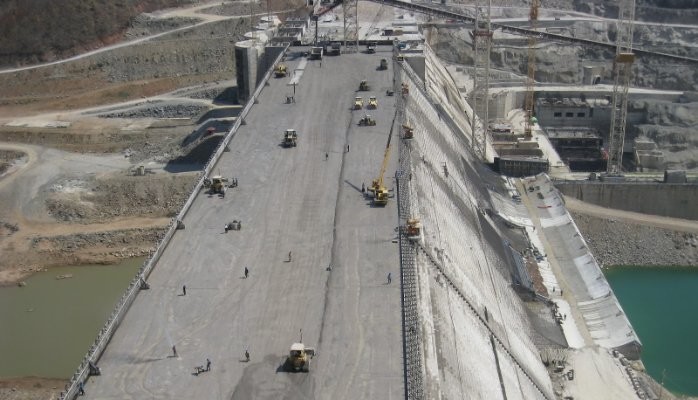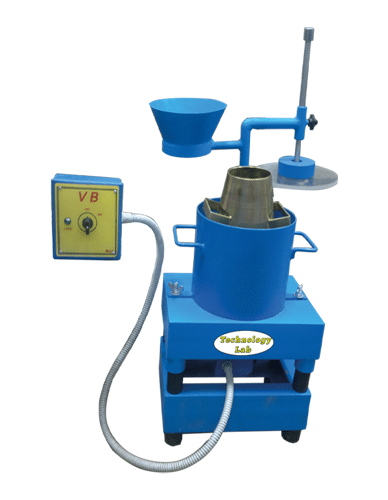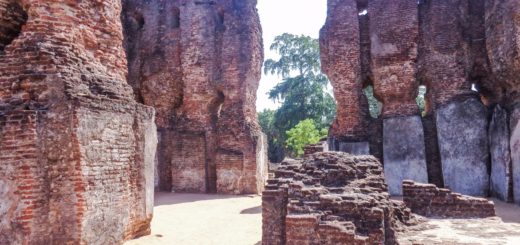Roller Compacted Concrete
Roller Compacted Concrete is also known as RCC is a kind of concrete widely used in occasions where a massive concrete volume is required.
Not like normal concrete, it does not include the reinforcements to carry the load applied to the structure. Further, RCC is used mostly in gravity structures or in structures that are not subjected to considerable tensile stresses.
Typical examples for structures are as follows.
- RCC Dams
- Subbase for road construction
- Road Construction
What is RCC Concrete
Roller Compacted Concrete is a kind of concrete that contains fine aggregates, coarse aggregates, cement, and water. In addition, additives like fly ash may be added as per the requirement of the project.
Therefore, the material types used in RCC are the same as other types of concrete.
Generally, the aggregate size is higher than the normal concrete and it could be about 75mm. Depending on the design mix, the size of the aggregate may be varying.
Portland cement or cement combination with fly ash or any other is mostly used in larger concrete pours as a measure to reduce the heat of hydration.
Advantages of Roller Compacted Concrete
It the common practice to increase the size of the aggregates especially the coarse aggregates when the scale of the project is larger, the size of a concrete pore is significantly higher and the element sizers are comparatively large.
Let’s discuss the advantage of RCC,
Cost of Construction
The cost of construction is one of the main factors to be considered when finalizing the conceptual design. The use of innovative methods that may be deviated from conventional practices could save a reasonable amount of money.
RCC is also such a method that brings the economy into the project. It is known that the reduction of the cost of roller-compacted concrete would be in the range of 25%-50% than the conventional concrete.
Rapid Construction
Construction can be carryout in a 24-hour basis when there are no obstructions physically. Further, the only work to be done in the majority of the area is to pour the concrete and compact it. Therefore, the time taken is less when compared with conventional concrete.
Minimize the Diversion and Coffer Dams
A significant cost needs to be spent on construction support work such as diverting the river. Construction of cofferdam and diversion channel/tunnel is a must in most of the projects.
Depending on the flood expected during the construction period, the design of the cofferdams and tunnels is done in a way that does not obstruct the construction by flooding.
When the RCC dam is constructed, the size of the cofferdam and the tunnels could be reduced as it is possible to reduce the return period.
A certain degree of overtopping could be allowed for the roller compacted concrete dams as it gets the strength and carries the load once the concrete gets hardened.
Not like other types of dames, this is a very useful feature available with RCC dams.
Further, a high rate of construction also enables the use of the main dam before completing the construction.
How to Define the Roller Compacted Concrete
Two methods can be used to specify the RCC concrete. This is based on the method that the mixture is specified.
- Soil compaction approach
- Concrete engineering approach
Soil compaction approach
When the principles of the soil mechanics are used to specify the roller-compacted concrete, it is based on the maximum dry density. We check the achievement of the maximum dry density of concrete at the site by the compaction. The usual test used to check the compaction for the soils can be used in this method.
The optimum moisture content is checked and accordingly, the maximum dry density can be found. Higher the compaction, the higher the strength of the concrete.
Concrete engineering approach
The conventional method used to specify the concrete is used in this method. It is the concept initiated with the water-cement ratio and defining the characteristic strength for the concrete.
This method is more familiar with compared to the previous method and it is easy the check. We used general quality control and quality assurance procedures to make sure the construction is acceptable.
Feature of RCC
Now, let’s list some of the key technical aspects related to the roller compacted concrete.
- RCC is not same as the conventional concrete and it is compacted with rollers.
- Low slump is maintained and thus less water-cement ratio can be maintained.
- Since it is a place by layer and compacted in layers, there no very high cost for formwork.
- One layer is about 300mm and does the compaction. The thickness of the layer is depending on the maximum size of the aggregates, the type of vibratory equipment used for the compaction, etc.
- No stopping. Construction can be continuing on a 24×7 basis.
- Most of the time cementitious additives like fly ash are used to reduce the heat of hydration. F Class fly ash which contributes to low heat of hydration is more commonly used in construction.
- Cement can be replaced from fly ash by up to 50% by volume.
- The typical nominal size of the aggregate is 75mm.
Mix Design of RCC
Mix proportions shall be selected for economical construction while maintaining the durability and construction requirements.
There are several factors to be considered when deciding the concrete mix.
- Durability
- Strength
- Workability
- Heat of Hydration
- Aggregates
- Water Content
Durability
Durability is the key factor consider modern construction. Not like old codes, new codes specify the durability requirements as the baseline of the design.
The articles factors affecting durability of Concrete and durability requirements of concrete discuss more on the durability of normal concrete.
The designer needs to initiate the design with the durability requirements and specify the structural material and composition to be used.
For example, when we designing a building, firstly we find the exposure class and find the concrete grade, minimum cement content, water-cement ratio, etc.
The durability of RCC concrete depends on many factors such as strength, cementitious material content, quality of aggregates, percentage of compaction, etc.
Strength
The strength of the concrete reflects the structural capacity of the element. The same as conventional concrete, it is required to make sure the concrete having the specified strength during the construction.
Workability
Workability of the RCC concrete not that dominant like the conventional concrete which required higher workability to pore the concrete in between the reinforcement bars.
However, there is a requirement of placing and compacting the concrete without segregation. Further, the workability of the RCC concrete is not specified in terms of the slump as there is no slump.
The consistency of the roller compacted concrete is measured from Vebe apparatus.
Heat of Hydration
RCC is unreinforced and there is no element to carry the tensile stresses induced during the hardening process.
Early age thermal cracks, cracks due to the high heat of hydrations need to be controlled by concrete itself.
The use of the low water content enables to use of low cement content and the use of cementitious materials such as fly ash also reduces the heat generated in the hydration process.
Further, the possibility of replacing the cement even up to 50% of the volume is a greater advantage in reducing the rise of the temptation in the concrete when it hardened.
Aggregate
Aggregate plays a major role in the RCC concrete as it contributes largely to the strength and the durability of concrete.
Use of optimum size of aggregate produces better mix. Larger the size of the aggregates, increase the issue like segregation, spreading, low compaction, etc.
Generally, 75mm is considered as the maximum size of coarse aggregates.
Water Content
Low water content is used for the roller compacted concrete.
The content of the water to be used for the mixture is based on the consistency and the strength of the concrete. The content of water is specified in EM 1110-2-2006 is based on the Vebe consistency.
Further, the higher the size of aggregates lesser the content of water to be added.
Properties of Roller Compacted Concrete
Though the roller compared concrete also a type of concrete, there are some considerable differences compared to the conventional concrete.
Let’s discuss each of them in detail.
Compressive Strength
Compaction of the RCC concrete is considered acceptable when the percentage of air voids less than 1.5. Containing 5% of voids after the compaction due to the inadequate/incomplete compaction could result in a loss of strength of about 30%. Further, air voids about 20% can reduce the strength of the RCC concrete by 80%.
The compressive strength of RCC is comparatively lower when compared with conventional concrete. As specified in the EM 1110-2-2006, the RCC may design for the minimum strength of 13.8 MPa for durability reasons along.
Further, the development of the strength of the concrete not that short like normal concrete. It may consider in 90 days, one year strength, etc.
Tensile Strength
Not like normal concrete were having the reinforcement to carry the tensile stresses, roller-compacted concrete has a much higher concern on the development of tensile stresses.
The type of categorization can be observed based on strength development.
- Direct Tensile Strength
- Lift Joint Direct Tensile Strength
- Splitting Tensile Strength
- Flexural Strength
- Dynamic Tensile Strength
Creep
Creep is a time-dependent strain due to the sustained loading.
It increases the strain in the concrete with time. The rate of increase will reduce with time.
Creep depends on o the material properties. The concrete having a high modulus of elasticity and high strength will generally have relatively low creep strains.
Volume Change
The volume of the concrete changes when it gets hardened.
It could be due to two main reasons
- Drying Shrinkage
Reduction in volume of the concrete when it dry is called drying shrinkage.
It mainly depends on the content of water and the characteristics of the aggregates.
- Autogenous Volume Change
This is also called autogenous shrinkage which is a kind of shrinkage in the concrete.
Reduction of volume is caused by the hydration of the cementitious material without the concrete gaining or losing moisture.
Change in the volume can be significant in large volume concretes. Further, the duration of the autogenous shrinkage can last much longer than the drying shrinkage.
Permeability
Permeability of the RCC concrete is very important when water retaining structures such as dams are constructed.
It depends on mix proportions, placement method, degreed of compaction, etc.
Further, the higher the content of cement lowers the permeability.
Generally, well-compacted concrete has permeability in the range of 1.5 to 150×10-8 mm/sec.
Crack Controlled Methods in RCC Structures
- Temperature Control
Temperature control is the same we do for the conversion concrete. The following actions are taken to reduce the rise of the temperature.
- Limit the rise of the temperature in the mixture.
- Limit the placing temperature
- Use of insulations
- Pour concrete at night
- Precooling Techniques
The following actions could be taken to reduce the heat in the concrete.
- Use ice replacing water
- Use liquid nitrogen to cool the RCC mixer
- Transverse Contraction Joints
Constructing vertical transverse joints in the upstream side of the RCC dames is done allowing the thermal movements. A water bar will be placed in these joints to avoid the movement of water across the joint.
The article types of dam could be read for more information on the design and construction aspects of different types of dams.





